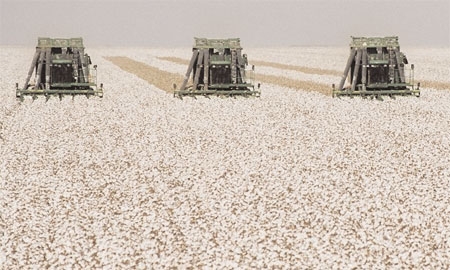If Brazil is the breadbasket of the world, then Mato Grosso is the breadbasket of Brazil. The large central western state that borders with Bolivia is the world’s single largest producer of soya, with annual production reaching close to 18 million tons, worth US$6 billion in exports in 2009. Cotton and cattle are also important exports.
Largely isolated from the rest of the country and economically underdeveloped until the 1970s, Mato Grosso is a perfect example of the successful drive to increase agricultural production and crop yield through technology and research, spearheaded by entities such as EMBRAPA over the past 40 years in Brazil.
Today Mato Grosso is the sixth-largest exporter among Brazilian states, and its thriving agricultural sector, which represents 72% of the state’s GDP, has been the main factor behind the astonishing economic growth rate of 124% between 2002 and 2008.
Since Mato Grosso is primarily an exporter of agricultural commodities, there is a now drive to create more incentives for an increased industrialization of the region, in order to export more value-added products, particularly in the food and beverages and wood industries.
BENEFITING FROM R&D INITIATIVES, AGRICULTURE NOW REPRESENTS 72% OF MATO GROSSO’S GDP AND THE STATE EXPERIENCED ECONOMIC GROWTH OF 124% BETWEEN 2002 AND 2008
THERE IS A DRIVE TO CREATE INCREASED INDUSTRIALIZATION IN THE REGION IN ORDER TO EXPORT MORE VALUE-ADDED PRODUCTS, ESPECIALLY IN THE FOOD, BEVERAGES AND WOOD INDUSTRIES
THE 2014 FIFA WORLD CUP WILL BE A DEFINING MOMENT FOR THE STATE, ATTRACTING THE INTERNATIONAL SPOTLIGHT AND SHOWCASING ITS BUSINESS AND TOURISM POTENTIAL
|
However, perhaps the most significant aspect of Mato Grosso’s booming agribusiness is the sustainability of its model: despite the record-breaking figures of soya, cotton and cattle production, 64% of the state’s 348,788 square miles is made up of preserved areas.
Mato Grosso’s natural richness is by no means limited to agricultural production, and the state boasts the unique characteristic of being home to three of Brazil’s six biomes.
The north of the state is covered by the southern part of the Amazon rainforest. The Pantanal, the largest tropical wetland in the world and one of the state’s star tourist attractions, lies to the west, whilst the tropical savanna known as the Cerrado covers the east.
This rich natural heritage and immense biodiversity represent a huge potential for tourism, which so far has gone relatively unexplored, partly due to the distances from main cities like São Paulo and Rio de Janeiro and partly due to a lack of promotion.
This scenario is set to change radically since Cuiaba, the state capital, was selected as one of the 12 hosting cities of the 2014 FIFA World Cup. The world’s largest sporting event will attract the international spotlight to Mato Grosso and represents an unprecedented opportunity to showcase the state’s business opportunities and tourism potential. The hope is that the event will serve as a catalyst for the diversification of the state’s economy and as a platform to promote its tourism potential.
A total of 26 major projects are under way in preparation for the event, including the construction of the new, multipurpose stadium, with a capacity of 43,000 people.
Thanks to the necessity to be ready in time for the World Cup, new roads, highways and a bus rapid transit system will be built.
With a population of 700,000 that is estimated to hit the 1 million mark by 2014, the metropolitan area of Cuiaba faces growing difficulties with urban mobility. The international airport will also see its capacity rise to 2.5 million passengers a year by 2014.

0 COMMENTS